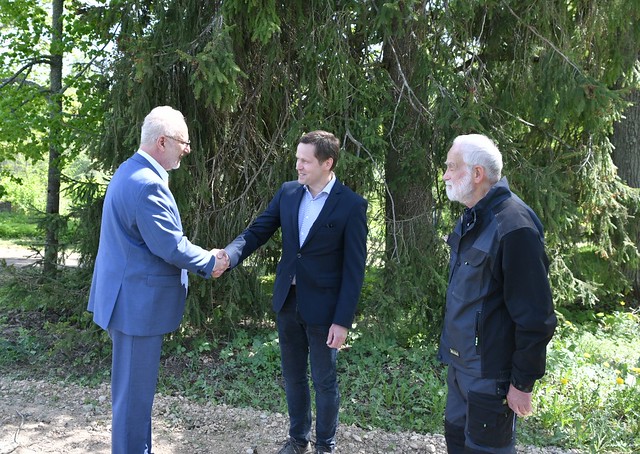Dear Mr. Pēteris Stradiņš!
Dear descendants of Jānis Stradiņš and members of the "Stenders’ Society"!
Honourable Chairman of the Council!
Distinguished guests!
I am honoured to be here, in the spiritual centre of the Sunākste cultural and historical district, where a special memorial to the academician Jānis Stradiņš is being created.
I would say that this is not only a memorial to Jānis Stradiņš, but also a place where one can reflect on the world, on life, and on Latvia.
Like many of you, I knew Jānis Stradiņš during his lifetime. His versatile activity, both in science and at the University of Latvia, and later at the Latvian Academy of Sciences and elsewhere, always inspired respect. His encyclopaedic knowledge was highly valued.
In the wider society, Jānis Stradiņš first became known as a researcher of the history of science and culture, its narrator to a wider audience.
Even during the Soviet occupation, he was aware of and tried to promote the cultural and historical traditions of Latvians and Latvia.
Jānis Stradiņš was always present wherever important events took place. He was often the instigator of major cultural and scientific events.
Jānis Stradiņš is an example of how a scientist can serve his homeland and at the same time belong to the world.
Throughout his life, he aligned his individual spiritual scale with the needs of his people, awakening and raising the nation's self-confidence.
Lutheran theologian Gotthard Friedrich Stender also lived and worked in Sunākste. Stender is one of the most influential personalities of the Age of Enlightenment in Latvia and one of the promoters of Enlightenment ideas. The growth and development of Latvia was very important to Old Stender. We automatically associate his spiritual legacy with the name of Sunākste. It is being thoughtfully nurtured and promoted, especially on the way to the quincentenary of the Latvian book, which we will celebrate in two years' time - in 2025.
Stender once said, "The more a people grow in true good wisdom, the more its happiness rises".
We Latvians owe Stender a debt of gratitude for the first Latvian alphabet book, for the Book of High Wisdom and for the beginning of Latvian secular literature. 270 years ago, Stender also produced the first translation of fiction into Latvian.
Stender spread the ideas of the Enlightenment in the Duchy of Courland and Semigallia and, as is well known, these ideas led to the abolition of serfdom in the gubernias of Courland and Vidzeme.
Johann Brotze, Garlieb Merkel and pastor Watson came after him.
Jānis Stradiņš, a native of Riga, spent his childhood summers in Sunākste. Perhaps it was growing up here and the impressions gained that turned the future scientist into a protector and patriot of small, local places. Sunākste really has something to be proud of.
The fundamental collective work "Latvia and Latvians" was also written on the initiative of Jānis Stradiņš and under his editorial direction. It is the most extensive collection of academic articles about ourselves ever published. This unique work, however, still awaits wider public attention.
Janis Stradiņš was a man of integrity. One of the few who did not shirk responsibility, but took it. He admitted: "The history of Latvia is a history of compromise, uncertainty, conformity and adaptation. However, in the case of a small nation, tossed by the blows of fate, it would be one-sided and perhaps even unfair to judge it. "We must evaluate the history of our nation in the circumstances in which it was created”. These are the reflections of Jānis Stradiņš on the long history of our nation.
It is a reflexive tradition, and I said at the beginning that this place could be one where people come and think about what Stradiņš and Stender have said, as well as about political and cultural ideas in the world.
Incidentally, the term “Third Awakening” was also coined by Jānis Stradiņš. In the 1980s and 1990s, he was actively involved in the processes of reconstruction of the Latvian state. Being an activist of the Third Awakening and at the same time a patriot of Sēlija, Jānis Stradiņš pointed out long ago that the Republic of Latvia and its Constitution, established in 1918, had four regions: Vidzeme, Kurzeme, Zemgale and Latgale. However, a fifth region is missing. Jānis Stradiņš believed that the fifth largest Latvian tribe, the Selonians, belonged there.
Stradiņš wrote about Sēlija that it could be defined in different ways - as the area of the ancient Selonian tribe, which actually extends into Lithuania, as an ethnographic region with Selonian dialects, and as a cultural and historical region with its own distinctive mentality and cultural and historical features.
Stradiņš had already envisaged Sēlija as a potential administrative unit - either a region, a county or a district.
Today, for us, Sēlija is the historical Latvian land.
The Stender Society, whose founder and member was Jānis Stradiņš, has also contributed to this matter.
I am very happy that Pēteris Stradiņš is continuing what his father started. Once again, thanks to the Stender Society for the good cooperation! Thank you also to the "Sēlija Association", other associations and all Selonians!
Dear friends!
Today, in this sculptural ensemble "Gate of Light", we will leave a message in a time capsule for our descendants.
Let us also remember this statement by Jānis Stradiņš: "There must always be a handful of idealists who turn an imaginary Latvia into a real, viable country".
May these words be a strength to everyone who serves Latvia and selflessly gives a part of themselves to the Latvian state and our nation - Latvians!





